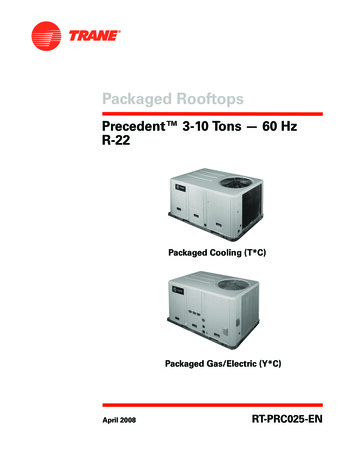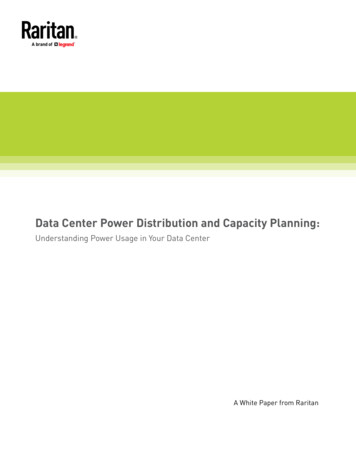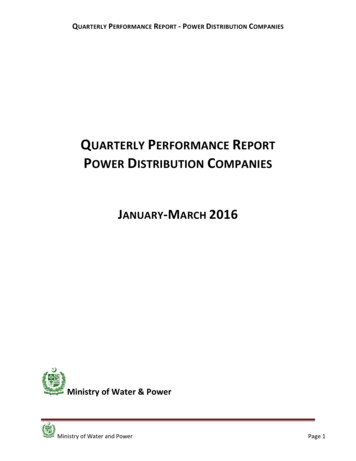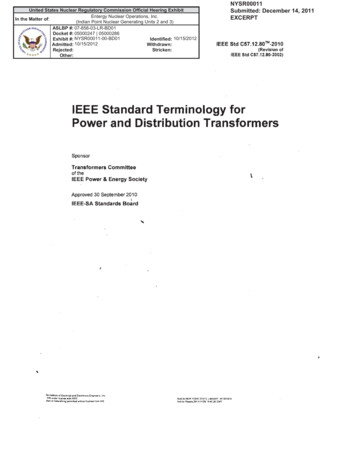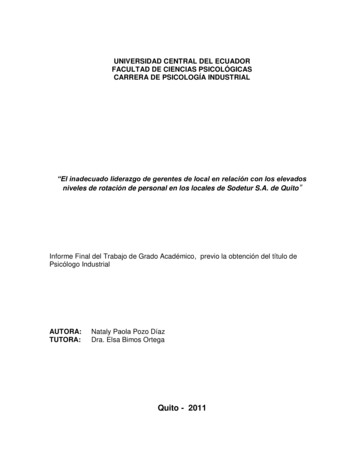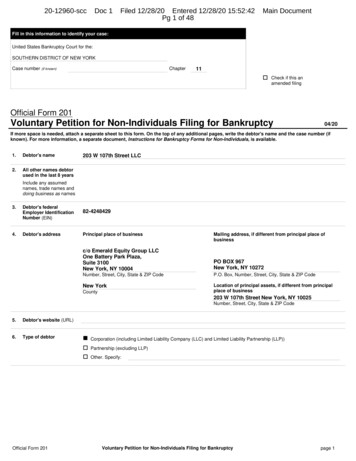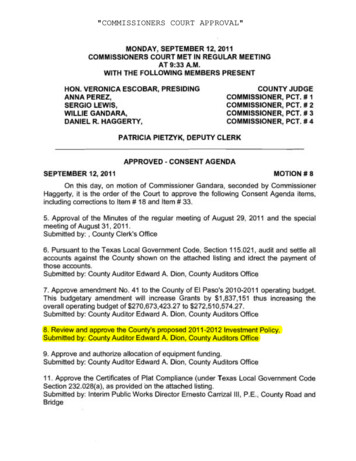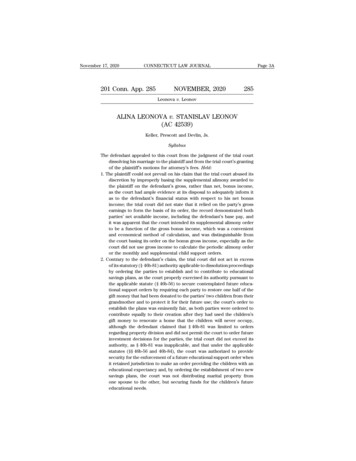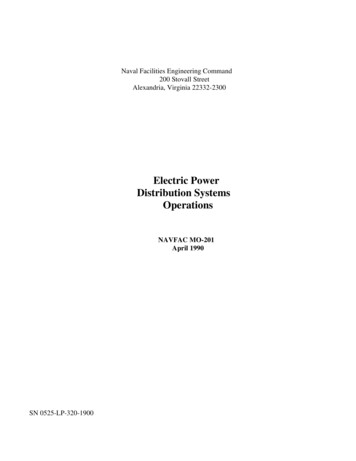
Transcription
Naval Facilities Engineering Command200 Stovall StreetAlexandria, Virginia 22332-2300Electric PowerDistribution SystemsOperationsNAVFAC MO-201April 1990SN 0525-LP-320-1900
FOREWORDThis manual on electric power distribution systems is one of a series developed to aid utilitysupervisory personnel at shore establishments in the performance of their duties. It includesinformation obtained from extensive research of current literature on the subject and preferredpractices based on practical experience. The principles and procedures described are inaccordance with national professional society, association, and institute codes.Additional information concerning procedures, suggestions, recommendations ormodifications that will improve this manual are invited and should be submitted throughappropriate channels to the Commander, Naval Facilities Engineering Command, (Attention:Code 165), 200 Stovall Street, Alexandria, VA 22332-2300.This publication has been reviewed and approved in accordance with the Secretary of theNavy Instruction 5600.16A and is certified as an official publication of the Naval FacilitiesEngineering Command. It cancels and supersedes Operation of Electric Power DistributionSystems, NAVFAC MO-201, November 1963, in its entirety.D. B. CAMPBELLAssistant Commander forPublic Works Centers and Departmentsi
PAGE ii INTENTIONALLY LEFT BLANK
ABSTRACTApplication principles and procedures for the operation of electric power distribution systemsand associated major apparatus are presented. The contents include principles of power systems,cabling systems, electrical equipment, power system protection and coordination, instrumentsand meters, operational procedures, and electrical utilization systems.iii
PAGE iv INTENTIONALLY LEFT BLANK
CHANGE CONTROL SHEETDocument all changes, page replacements, and pen and ink alterations posted in this manual.AMENDMENTNUMBERAMENDMENTDATEPOST DATEVPOSTED BY(LAST NAME)
PAGE vi INTENTIONALLY LEFT BLANK
CONTENTSPAGECHAPTER 1PRINCIPLES OF POWER SYSTEMS1-11.1 Typical Power Network. 1-11.2 Electric Power Generation. 1-21.3 Alternating Current Power Transmission System. 1-31.4 Primary Distribution Systems. 1-41.5 Secondary Distribution Systems. 1-91.6 Emergency and Standby Power Systems. 1-15CHAPTER 2POWER DISTRIBUTION CABLE SYSTEMS2-12.1 Cable Specifications. 2-12.2 Cable Construction. 2-12.3 Cable Ratings and Selection Criteria. 2-52.4 Types of Cable Installations. 2-72.5 Power System Applications. 2-10CHAPTER 3POWER SYSTEM ELECTRICAL EQUIPMENT3-13.1 Major Apparatus. 3-13.2 Transformers. 3-23.3 Voltage Regulators. 3-163.4 Switches. 3-213.5 Circuit Breakers. 3-263.6 Automatic Circuit Reclosers. 3-383.7 Power Capacitors. 3-443.8 Distribution Substation. 3-53CHAPTER 4POWER SYSTEM PROTECTION AND COORDINATION4-14.1 System Protection Methods. 4-14.2 Short-Circuit Currents. 4-24.3 Relays. 4-84.4 Applied Protective Relaying. 4-154.5 Fuses. 4-194.6 Low-Voltage Circuit Breakers. 4-254.7 System Coordination Study. 4-28CHAPTER 5POWER SYSTEM INSTRUMENTS AND METERS5-15.1 Instrumentation and Metering. 5-15.2 Instruments. 5-35.3 Meters. 5-6vii
CONTENTS (continued)PAGECHAPTER 6POWER SYSTEM OPERATION6-16.1 Power System Structure. 6-16.2 Control Center Procedures. 6-26.3 Switchboards. 6-56.4 Safety and Environmental Requirements. 6-8CHAPTER 7ELECTRICAL UTILIZATION SYSTEMS7-17.1 System Voltages. 7-17.2 Equipment Nameplate Ratings and Nominal System Voltages. 7-17.3 Street Lighting Systems. 7-3CHAPTER 88.18.28.38.4MANAGING THE OPERATION OF ELECTRICAL DISTRIBUTIONSYSTEMS8-1Operations Overview. 8-1Operations Management. 8-1Maintenance Management. 8-9System Planning Studies. 8-14CHAPTER 9NEW AND EMERGING TECHNOLOGY9-19.1 Supervisory Control and Data Acquisition. 9-19.2 Control Circuits and Devices. 9-49.3 Cogeneration. 9-69.4 Variable Speed Electric Drive Systems. 9-7APPENDIX AOperating Responsibilities and Organizational Relationships. A-1BIBLIOGRAPHY. Bibliography-1INDEX. Index-1viii
FIGURESFIGURE 13-123-133-14TITLEPAGETypical Electric Power Generation, Transmission, and Distribution System. 1-1Typical Distribution Substation Arrangements. 1-5Typical Bus Arrangements. 1-7Four Primary Feeder Arrangements. 1-8Conventional Simple-Radial Distribution System. 1-11Expanded Radial Distribution System. 1-11Primary Selective Distribution System. 1-12Loop Primary-Radial Distribution System. 1-12Secondary Selective-Radial Distribution System. 1-14Secondary Network Distribution System. 1-14Secondary Banking Distribution System. 1-16Engine Generators (Parallel Operation). 1-20Peak Load Control System. 1-20Combined Utility-Generator System. 1-20Rotating Flywheel No Break System. 1-24Nonredundant UPS System. 1-25Nonredundant UPS System with Static Bypass. 1-25Redundant UPS System. 1-26Delta-Wye. 3-8Wye-Delta. 3-8Wye-Wye. 3-9Delta-Delta. 3-9Zigzag. 3-10Open-Delta. 3-10Scott Connection (Three-Phase to Two-Phase Transformations). 3-11Six-Phase Star (Three-Phase Delta to Six-Phase Star Connection). 3-11Zigzag Three-Phase Grounding Transformer. 3-15Bypass Switching Arrangement for Single-Phase Voltage Regulator. 3-20Three-Phase Vacuum Loadbreak Switch (Reproduced Courtesy ofMcGraw-Edison Company). 3-24Circuit Breaker Arc Chute Interruption.(Reproduced Courtesy ofWestinghouse Electric Corporation). 3-28Padmounted Vacuum Circuit Breaker (Reproduced Courtesy ofMcGraw-Edison Company). 3-30Low-Voltage Metal-Enclosed Air Circuit Breaker Switchgear(Reproduced Courtesy of Westinghouse Electric Corporation). 3-32ix
FIGURES (continued)FIGURE LEPAGEAutomatic Oil Circuit Reclosers (Reproduced Courtesy ofMcGraw-Edison Company). 3-40Typical Single-Phase Automatic Recloser Construction(Reproduced Courtesy of McGraw-Edison Company). 3-41Pole Mounted Capacitor (Reproduced Courtesy of McGraw-EdisonCompany). 3-46Metal-Enclosed Capacitor Bank (Reproduced Courtesy ofMcGraw-Edison Company). 3-47Open-Rack Capacitor Installation (Reproduced Courtesy ofMcGraw-Edison Company). 3-48Symmetrical Short-Circuit Current Wave. 4-5Decreasing Symmetrical Short-Circuit Current. 4-6Asymmetrical Short-Circuit Current Wave. 4-7A Typical Power System and Its Zones of Protection. 4-16Open Fuse Cutout (Reproduced Courtesy of McGraw-Edison Company). 4-23Open-Link Cutout (Reproduced Courtesy of McGraw-Edison Company). 4-24Time-Current Curve Band. 4-32System Model. 8-18TABLESTABLE NO.3-13-23-34-1TITLEPAGETroubleshooting Chart for Circuit Breaker Operation. 3-36Overvoltage Limits. 3-52Expected Soil Resistivities. 3-54Relays Generally Used for Motor Protection. 4-19ACKNOWLEDGEMENTSAll photographs were provided, without charge, courtesy of the Power System Group,McGraw-Edison Company, Pittsburgh, PA and Westinghouse Electric Corporation,Pittsburgh, PA.x
CHAPTER 1. PRINCIPLES OF POWER SYSTEMS.1.1 TYPICAL POWER NETWORK. An understanding of basic design principles is essential inthe operation of electric power systems. This chapter briefly describes and defines electric powergeneration,
Electric Power Distribution Systems Operations NAVFAC MO-201 April 1990 SN 0525-LP-320-1900. FOREWORD This manual on electric power distribution systems is one of a series developed to aid utility supervisory personnel at shore establishments in the performance of their duties. It includes information obtained from extensive research of current literature on the subject and preferred
